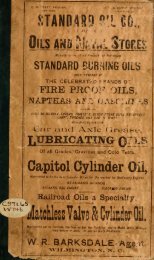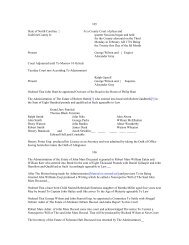11/25/07 VERSION: BEDSOLE HISTORY FROM 1673 ... - NCGenWeb
11/25/07 VERSION: BEDSOLE HISTORY FROM 1673 ... - NCGenWeb
11/25/07 VERSION: BEDSOLE HISTORY FROM 1673 ... - NCGenWeb
Create successful ePaper yourself
Turn your PDF publications into a flip-book with our unique Google optimized e-Paper software.
eally tight. The shirt collars were buttoned all the way up. The shirt sleeves were<br />
rolled all the way down and tied tight around the wrists. Still, the velvet got inside the<br />
shirts, up the sleeves, up the pants legs, and inside the clothes. With the weather<br />
around one hundred degrees in the summer and the humidity at about ninety-five<br />
percent and these beans being down among the corn where no breeze could get to<br />
the workers, picking them dressed as they were, was pure torture for days on end.<br />
The weaker workers frequently fainted from aggravation and heat exhaustion.<br />
Gathering Corn<br />
The ears of corn had to be pulled from the stalks and put in a sack with a strap<br />
which was worn around the neck. The leaves on corn stalks are also lined on each<br />
side of the leaf with reversed needle-like stingers and a leaf will cut ones skin like a<br />
knife. Then the sweat would get in the cuts and burn like fire. By the time they had<br />
been carrying that fifty pound bag of corn around their necks and dumping it in the<br />
wagon for twelve hours, their shoulders and backs would be throbbing and hurting<br />
so badly, they could hardly keep from crying. Working among the stalks of corn<br />
meant no breeze could get to them and the heat was torture. Every time their sacks<br />
were full, it was carried and emptied into the mule-drawn wagon. When the wagon<br />
was full, the corn was hauled to the barn and unloaded and stored inside. With one<br />
hundred or more, acres of corn, this was no small job. Corn was used primarily for<br />
animal feed and for meal and<br />
human consumption in the form of cornbread. If the family had children age five or<br />
higher, they did much of this work. Its hard to imagine today’s children doing any<br />
such job, even for five minutes.<br />
Picking Cotton<br />
This was one of the worst, hottest, time-consuming jobs that ever existed in any<br />
Bedsole’s life. With a 7-foot long canvas sack strapped around ones neck and<br />
shoulders, the cotton was picked and put into the sack, which dragged on the<br />
ground behind the worker, who was either bent over at the waist, or on their knees,<br />
down among the cotton stalks. The cotton bolls all had needle-sharp prongs<br />
surrounding the ball of cotton and when the picker tried to get the cotton, these<br />
prongs would inevitably stick into the finger tips and break off under the skin,<br />
causing the pricks to fester and become swollen, red, inflamed and extremely<br />
painful. Within the short span of one day, several of these sores would already be<br />
infected in all the fingers which only made the work more painful and being more<br />
careful when picking the cotton, only added to the amount of time to harvest it. When<br />
workers were paid for this work, even in the 1940’s, it was half a cent per pound<br />
picked. A normal cotton picker would usually pick 100-1<strong>25</strong> pounds in a day. That<br />
would yield the mind-boggling sum of fifty to sixty five cents for the entire<br />
twelve-hour day. Of course, back in the 1700-1800’s, it was a lot less. When picking<br />
in the early morning, the landowner would pay a lot less per pound due to the dew<br />
being on the cotton which he claimed, added false weight to the cotton.










